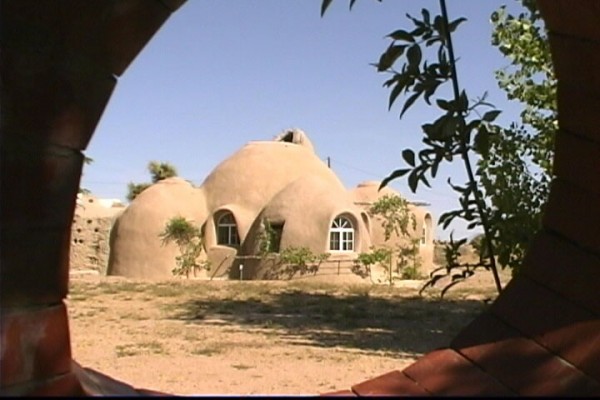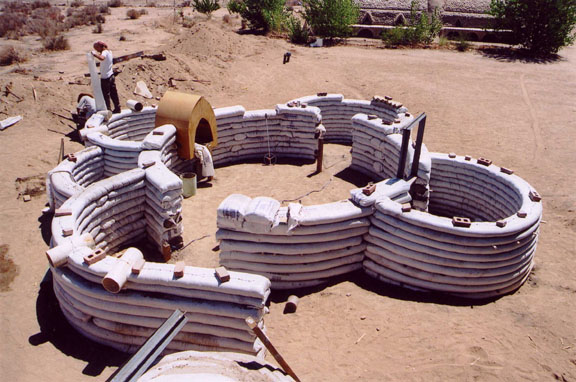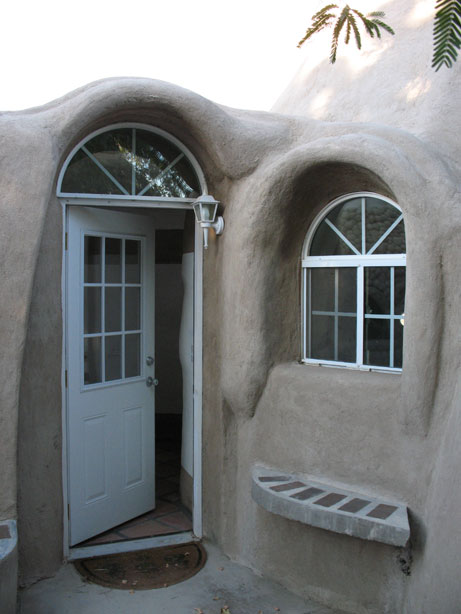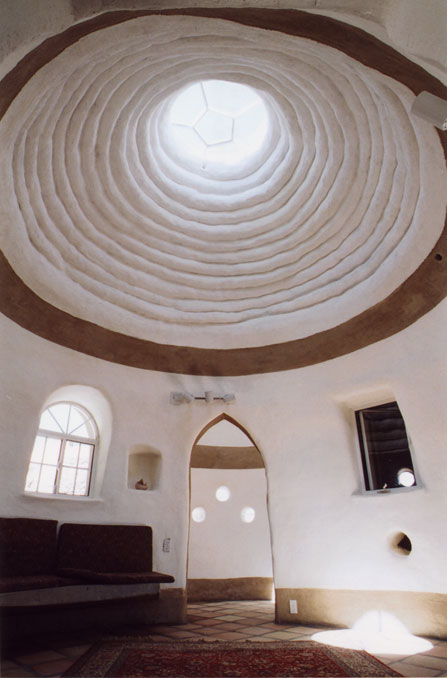CalEarth’s Eco-Dome can be built out of nothing more than dirt, barbed wire, and the same kind of polyethylene bags used to make sandbags to contain floods. The house will probably last longer if you mix some cement with the dirt, but it’s not absolutely necessary.
The bags come in the form of a continuous tube, and the house is constructed of layers of dirt-filled “snakes,” with barbed wire laid between them to keep them from moving.

This 400 sq. ft. home is one of CalEarth’s plans that can be built from the dirt on your land.
It’s 21st-century adobe: faster and easier than traditional adobe construction, because you don’t have to make and dry individual bricks. This construction technique can be learned quickly by anyone, and is about the cheapest possible way to build lasting shelter. But these are by no means temporary buildings; they are so robust that they meet California building codes.
Plans and a DVD and bags are available at the CalEarth’s Eco-Dome web site.
Eco-Dome video of the construction:
httpv://www.youtube.com/watch?v=WMNzoWkXTtc
Eco-Dome pictures of the structure.





Where is this house located?
This isn’t meant to be a reply to David, in my ignorance, I was unable to figure out how to create a new post.
I have been searching the net since I saw eco-domes on Extreme Homes, to see if they can withstand harsh midwest(U.S) winters.
I can’t seem to find a source. Does anyone have an answer?
I think they’re great, I’d love to have this as an option in the not too distant future when I’m looking to “buy”.
Hi David,
This dome is located at the Cal-Earth Institute Site: 10177 Baldy Lane, Hesperia CA 92345. You can also learn more by going to the site at: http://www.calearth.org/EcoDome.htm
Kent
What was the total cost to build this house not counting the land cost.
Hello Dave,
How long do the bricks (or snakes) take to dry? Can the snakes be made shorter (1/2 the length) so a woman could
carry and build this dome dome home?
To answer your question Jean, For female builders You can get scoria (volcanic rock) to fill the bags. Scoria is super light, insulating for cold climates. Or alternately, fill the bag 1/3, place bag and fill the rest of the bag in place.
Hi Jean,
According to the photos on the ordering page you fill the tube as you go. Go to this link http://www.calearth.org/ProductsServices/bagorder.htm you should be able to handle it.
what is the wind scoop for?
hello,
i’m also interested why is wind scoop for? thnx
Ventilation.
These are apparently common structures in deserts in parts of Iran and Africa, as described in works by Nader Khalili and Hassan Fathy.
Apparently they operate both with wind and with convection currents. Khalili discusses them at fair length somewhere, but I have leant out my copy.
GREAT Home
see…
http://www.EarthBall.org
Later, Roger@RogerART.com
is that type of house be in a tropical humid climate (rainy and cyclons)?
how long does it take to build one
That would depend how many people you have working and the availability of materials. Please go to the EcoDome webiste for more information: http://www.calearth.org/EcoDome.htm You can also contact them and get more specific answers.
ok so how many hours would it take to build the 800 sq foot one with 10-12 people?
I personally don’t have the answer, you will need to get in contact with the people who have made them. Please see reply above and let us know what you find out.
Apparently it varies, but they felt safe with 10 weeks from soil analysis to a complete structure for one residence consisting of two of these and allowing another ten for internal details. The crew apparently had 5-7 people most of the time, including one trained person. My understanding is that no mechanical power was used on site other than the vehicles coming and going with equipment, personnel, and the very few supplies.
So I would say 5 weeks plus whatever kind of detailing you wish.
Each central dome was 15′ in diameter. With limited experience, I find that the spaces created by 9′ and 10′ domes quite to my taste. These are considerably faster. Apparently even a smaller crew can put a dome can go up within a week.
will this hold up in snow? rain? Need to know. Would like to build one.
They hold up fine in snow and rain. Flooding requires some care: proper choice of land and, in some circumstances, retaining walls would be necessary, as with any building. Finished over with lime plaster and painted, they’re as watertight as the next building.
The wind scoop is for ventilation, in lieu of expensive and energy-expensive fans and AC units.
The size of the bags should not change whether or not a woman can participate in construction, principally because you will NOT want to move the bags far once they are filled. You put the bag more or less where it will be, then move the earth to it.
I have read estimates of 4 rice bags/hour for 2 people working together. These aren’t the long tubes you see in the picture, but 50 and 100-lbs rice bags. If you can count out the length of the bags, then figure about 7″ per bag-row, that should give some idea.
marshall football 1971
deer myspace backgrounds
fei lun hai debut
wwwfamosasdesnudas com
www future fta com
realtree myspace layouts camouflage
martine gaillard images
sajian raya recipe chef wan
pictures of braids cornrows for males
precious moments valentine layouts
cerita berahi
nikki fritz movies clips
photos coroner nicole brown simpson
blank planner templates
battle arena naruto
plu blog malaysia lelaki
context clues assessments
philippine lotto daily results pcso
fesyen selendang pengantin
biography of kriss kross
sir how much it’s cost to built ano dome house? u have company who built here in philipphine?
nuas teens
carson pierre scott com
pro ana sites
xhuga fm com
people has a dick and pussey
zillions braids
us army m14a1 rifles for sale used
delta sigma theta fortitude poem
pellet gun silencers for sale
poly bale feeders
which kriss kross member died
7up pound cake eggs
the american pageant answer key
kite runner characters
inventions around 1642 through 1727
camaras bajo las faldas bragas
knowlwood kennels
online actual size ruler 1 ft
robin meade bio swimsuit
parks belk clothing
I just found this blog recently when a friend recommended it to me. I have been an avid reader ever since.
Looks like a great little place, cant help thinking of Star Wars tho when I look at them pictures.
That’s exactly what I was thinking when I saw this.
Has anyone seen any of these built (and lasting) in the Midwest? My son wants to build one here in Michigan, and I can’t see them lasting through our rains, let alone our winters.
i would like to build one or more in england and wondering whether they will withstand the rain and cold winters here..
my mother is interested in building one of these homes. realistically i do not think they are as easy as they advertise and i was wondering if anyone knows where i can see some reviews on them that are not affiliated with the designers? Also is their a list of states that this home would meet code with? any help would be great, thanks Stephen M.
Hey, thanks. Can it be made bigger than 400 sf and what is the cost psf? Serious about this. Also, how safe is it?
This house looks like it belongs in Mos Eisley!
estoy muy interesado pero… quiero saber si estas cúpulas resisten temblores/sismos?
FYI I have both 14 & 18” 2000 hr, UVI stabilized, woven pp tubing available for sale at $0.13 & $0.16/lf sold in 6000ft rolls sold by the roll only. I have sent these rolls nationwide and into Canada with nothing but thumbs up from everybody. They are perfect for Earth Bag building. FOB my facility in Southern California.
Thanks for your time.
Steve Villa Cell# 949-338-5978
good job.
here’s my design:
house interior 7x8wide, 7tall
http://www.flickr.com/photos/99405731@N05/9371779389/sizes/l/in/photostream/
sml house interior 6x8wide,3.5tall
http://www.flickr.com/photos/99405731@N05/9374561476/sizes/l/in/photostream/
house garden
http://www.flickr.com/photos/99405731@N05/9374544392/sizes/l/in/photostream/
optional: bathroom and kitchen slide over on top of the bed, to compact to 6foot wide, as a trailor for traveling, than unslide it and open it when its time to live in it.
optional: design so that electric and plumbing could be put into it later
to live w/o plumbing and electrical built in: sml solar panel, heating blankets, space heater, air conditioner, rain water collection, hand pump well, sml portable water purifier that purifys sewage haz waste and salt water. go the the bathroom outside in a compost/humanure heap or scattered around in large area not where it wont contaiminate water
dont build below 40feet above sea level, flood zones, or high-risk weather hazard zones
do you like my design? suggestions? would you consider building or living in my design? fluffybunnypuff@yahoo.com
This is truly such a great and innovative idea. I wonder if this type of structure works in just these desert types of environments. And I bet that there is a market for this type of lodging in the ecotourism industry.
hemen okey oynamak istiyorum turkiyeokey.com sitesi bedava okey oyna, free okey play
I saw the episode on hgtv . This is an amazing tiny home. My future home…
I enjoy your put up! Why didn’t I uncover this put up previously? Always keep up the great function!
These designs are only builable in San bernardino county California, as far as the USA is concerned. And the costs, from what I heard, was about $100k for 800sf with land, permits, etc. included. However these would be much cheaper abroad. Without strict regulations and cheap labor. I wish there were real testimonials available, calearth used to have these comments from real builder owners, but they removed that page.
I would like to be kept in the loop plan on building in near future but I wonder if you have any input sa how well these stand up to storm and high winds My thinking is should with stand almost any thing thank you for information and time